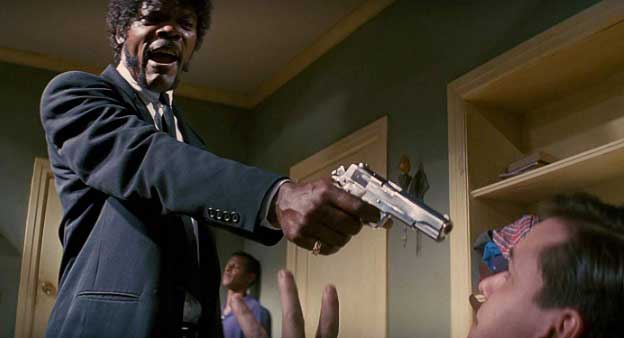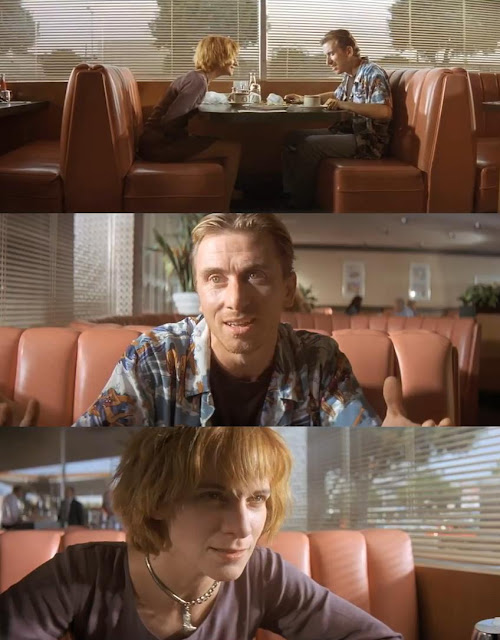Specialist Study Area 2: Auteur and Pulp Fiction
Questions in the exam could focus specifically on the ways in which Tarantino can be considered to be an auteur and the ways in which Tarantino's auteur signature contributes to the 'experimental' identity of Pulp Fiction. A number of other types of questions may require you to make reference to Tarantino as an auteur - even if the term is not in the title. Answers to questions on representation or aesthetics may include discussion of Tarantino's auteur signature and you should mention Tarantino as an auteur in essays about institutional context (how Tarantino's auteur style may have been 'encouraged' by Miramax). Any discussion of the other critical debate studied for experimental film - narrative - will invariably require at least some discussion of Tarantino's manipulation of narrative structure being a key element of Tarantino's auteur signature. It is highly likely that any question on auteur will lead you to discuss the ways that Tarantino's decisions regarding cinematography, mise-en-scene, performance, editing and sound can be considered to contribute to his auteur status and how his auteur style contributes to the 'experimental' nature of the film.
Remember, questions on auteur will require you to discuss, in detail, certain scenes from Pulp Fiction - so make sure you have at least two scenes that you can recall in detail. In reality (time permitting) it would be a good idea to also mention at least one other scene; remember, that you are writing a Film Studies essay and, therefore, examiners will expect you to support your points at all times with discussion of examples from the film.
Opening and closing scenes are always useful to know in detail - this is particularly relevant to an essay on auteur because of the fact that much of Pulp Fiction is told out of chronological order - a central element of Tarantino's auteur signature - (so, you may consider Captain Coons' Gold Watch monologue to be the opening moment of the story - looking at the film this way foregrounds the narrative significance of the gold watch - whilst the diner scene with Honey Bunny and Pumpkin is the opening scene as presented in the plot). Try, also, to memorise at least one other key scene - and make sure that you are able to make brief passing references to a number of other moments in Pulp Fiction.
As auteur is one of the Specialist Study Areas for Pulp Fiction, it is highly likely that one of the questions in the exam will ask you to discuss Tarantino as an auteur. We have covered much of the material regarding the concept of auteur (and its origins) and the ways in which Tarantino can be considered to be an auteur, already on separate posts, but you should re-read the posts below (particularly useful will be the post on Pulp Fiction and postmodernism, as many of the conventions of this movement that are outlined are also key elements of Tarantino's auteur signature) to refresh your memory about the areas to discuss.
The term auteur, you should remember, is loosely derived from the debate among French film critics in the 1950s (and first coined by American film theorist Andrew Sarris in the early 1960s) about directors who were able to stamp some essence of themselves on the films they made during the creatively restrictive period of the Studio Era in Hollywood. During this period, directors were essentially contract-employees of the major studios they worked for (much like actors at the time, on long-term contracts), which churned out genre movies in a factory-like production model. Despite the restrictions to creativity of this model of film production (where films were overseen by studio heads) some directors, according to these critics, were able to imprint consistent themes and aspects of style upon the films they made. Directors were identified as the 'authors' of the films they made and films made by auteurs were considered art rather than mere entertainment.
Tarantino is most certainly a modern auteur (arguably the most recognisable auteur in the 21st century), returning over and over again to key themes and aspects of style, many of which are apparent in Pulp Fiction. Tarantino has a very strong, very noticeable, signature, some elements of which can be found below (and examples of which can be found throughout the blog):
- the use of vibrant colours
- a hyperreal approach to set design (Jack Rabbit Slims)
- retro clothing
- violence (often treated in a humorous way)
- the theme of redemption
- long takes, creating tension and developing character
- subverting conventional uses of film form/film language
- action set pieces, such as the 'Mexican stand-off'
- anti-heroes or the blurring of boundaries between protagonists and antagonists
- an eclectic mix of musical genres and eras, with songs frequently played in their entirety
- paying homage to old films/cult films/obscure movies/genre films
- intertextual, pop-culture references
- foregrounding dialogue (which is more realistic than plot-driving dialogue in many mainstream movies)
- drawing attention to the fact that the audience is watching a 'constructed' film and breaking the fourth wall
- casting older actors as a tribute to the roles they played as younger men and women
- manipulation of narrative structure and a playfulness with audience narrative expectations
Arguably the most important aspect of Quentin Tarantino's auteur signature to discuss is his manipulation of narrative structure. We have discussed this at length in relation to Pulp Fiction, but it is an aspect of the director's style that is apparent across the body of his work (as both a scriptwriter and a director).
In an interview in 1993, before the release of Pulp Fiction, Tarantino stated that "one of the things I like to do with my scripts is monkey with structure a little bit" and the shuffling of time and events in his movies has become a trademark of almost every film he has written or directed. Though this manipulation of temporal order has become less obvious in his later works, it is, nevertheless, still apparent and it formed part of his auteur 'calling card' during the early part of his career:
- Reservoir Dogs - the plot begins by presenting events from the middle of the story, showing the crew of thieves in a diner on their way to the robbery (which the audience never actually witness). The rest of the plot skips between the aftermath and the events leading up to the job, with some of the earliest recruiting scenes (of Mr Orange, in particular) shown towards the end of the plot (just before the end of the film)
- True Romance - Tarantino's first script delivers story events in the plot out of chronological order. When the script was made into a movie by director Tony Scott (after the success of Tarantino's Reservoir Dogs), Scott chose to present the narrative chronologically
- Natural Born Killers - the narrative structure of director Oliver Stone's movie (based on a script written by Tarantino) is really loose, with many of the film's scenes a series of obscure, seemingly unconnected experiments in style rather than causally linked, coherent events
- Jackie Brown - a film which is arguably the most linear of all of Tarantino's movies, shows moments from the film's final act from three different perspectives
- Kill Bill Volume 1 and 2 - both films employ a non-linear narrative structure with multiple story events presented out of chronological order in the plot (partly to mimic the structure and recall of human memory and partly to gradually reveal information about the Bride's past)
- Death Proof - shot and edited like an old exploitation movie from the 1970s, the narrative structure appears fractured partly as a result of 'missing reels' in the film (homage to real exploitation films that often suffered from narrative coherence as a result of missing scenes in some of the prints that were delivered to cinemas)
- Inglourious Basterds - structured in chapters, with characters (rather than story events) overlapping, though unlike many of Tarantino's films the story is presented largely in chronological order
- Django Unchained - relatively linear narrative structure apart from occasional flashbacks and flashforwards
- The Hateful Eight - the first half of the movie (the journey to the cabin) is presented chronologically but the second half of the film features multiple flashbacks and events presented from different perspectives as the characters gathered in the cabin lie and try to outwit each other
- Once Upon a Time in Hollywood - sticks to a largely conventional narrative structure though, as with Inglourious Basterds, the film's narrative resolution dramatically re-writes historical events
Throughout his career, Tarantino has had complete control over the films he has made and has been heavily involved in every aspect of filmmaking (from writing the script to working with the same crew - and often the -same actors - over and over again). With regards to aesthetics, Tarantino has a unique stylistic tone that many directors (particularly in the 1990s) have tried to copy, but which cannot easily be matched. Known for long, intense dialogue, humorously dramatic violence, and frequently nonlinear scripts, Tarantino undoubtedly has a signature mark. A well known common theme throughout his films is the revenge plot, exemplified in films such as True Romance, Kill Bill Volume I and Kill Bill Volume II, Death Proof, Inglorious Basterds, Django Unchained and The Hateful Eight (a theme on the margins of Pulp Fiction).
Other recurring elements include similar camera angles and shots (car trunk POV shots, mirror shots, close ups on lips and feet), the use of black and white or rear projection, violent awakenings, dance scenes, Mexican stand-offs, opening definitions and chapter headings (borrowed from literature), retro costumes and recurring props (samurai swords, record players, televisions). Tarantino frequently uses the same cast members and technical crew; actors that have appeared in Tarantino films include Uma Thurman, Samuel L. Jackson, Christopher Waltz, Tim Roth, Brad Pitt and Michael Madsen. Tarantino himself has also had multiple cameos in his films.
Typical questions related to auteur can be found below. It is important that you attempt them, combining the notes above with your own analysis of key scenes. When practicing essays it will help with your revision if you re-watch moments from the film and pick appropriate scenes to analyse. Remember, before you attempt a question on auteur you must re-read the other posts (links to which are earlier in this post) so that you have all the information you need.
1. Explore how far the auteur signature of your chosen film's director can be considered to be 'experimental'.
OR
2. 'Experimental film is often the result of an auteur challenging established conventions with fresh ideas.' Discuss this statement with reference to key sequences from your chosen film.
OR
3. 'Part of the pleasure of watching a film comes from a recognition of an auteur's style.' Discuss this statement with reference to key sequences from your chosen film.
OR
4. 'Style is more important than substance in the work of a contemporary auteur.' To what extent is this true in your chosen film?
OR
5. 'The style of a film has more of an impact on the spectator than the story itself.' With detailed reference to key sequences from your chosen film option, discuss the impact of the director's style on the meaning created in your chosen film.
OR
6. Discuss how far your chosen film reflects stylistic qualities associated with a particular director. Make detailed reference to particular sequences in your answer.
OR
7. To what extent does your the director's auteur signature contribute to the impact of your chosen film? Refer in detail to specific sequences.
OR
8. How far is the style of your chosen film option influenced by the director? Make detailed reference to particular sequences in your answer.













Comments
Post a Comment